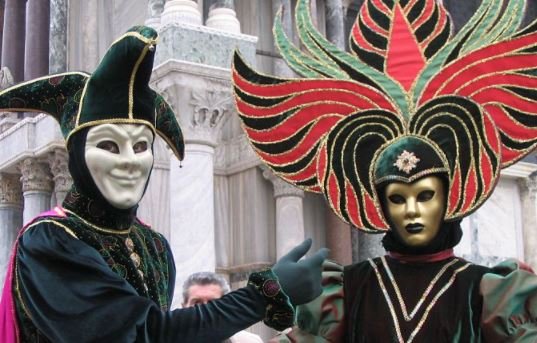Masquerade Ball: History and Major Facts

Masquerade ball history and facts
A masquerade ball is a social event that involves participants donning costumes and masquerade face masks. The goal of the event, aside from being one often meant for entertainment, involving dancing and social interactions, is to inject themes of mystery, intrigue and at worst high doses of decadence.
Dig into the intriguing history and major facts about the Masquerade Ball – a carnival celebration that dates back to the 14th and 15th centuries.
When and where did it all begin?
Masquerade balls began in medieval Europe and often took place during the carnival season. It was particularly popular with the not so affluent class. Participants often wore masks and well-designed, colored costumes to the event.
In France
With the passage of time, the event came to be used by nobles and royals across Europe to celebrate the arrival of princes, queens and kings to a city. Around 1393, France’s Charles VI organized one of the first royal masquerade balls. The “Burning Men’s Ball” or The “Bal des Ardents”, as it was known in French, helped popularize masquerade balls across France. The king and five of his courtiers put on a host of different masks and flax costumes while dancing like men from the wild woods. The ball was organized to celebrate the queen’s [Queen Isabeau de Baviere] lady in waiting’s marriage.
In Italy
Masquerade Ball made its way to Venice in the 16th century, a time when the Renaissance period was in full throttle. Venetian elites and aristocrats enjoyed attending the balls, which were often rife with scandals, excessive drinking, clandestine business transactions, inappropriate sexual interactions, and a host of other decadent activities.
Upon the demise of the Republic of Venice in the 18th century, patronage of Masquerade Balls started to plummet in Venice. It was subsequently embraced by the counts in Switzerland.
In England
The man who introduced masquerade balls into England was Count John James Heidegger. His time in Venice had a big influence on the count, and his reason to transfer the social event to gardens across London was aimed at cloaking the activities of unescorted ladies and drunken men of the night.
There were a few members of the society that criticized the event and called out its high level of immorality. In spite of those criticisms, masquerade balls continued to be very popular among some very high ranking members of the royal family and the government in general.
Other parts of Europe
Again the scandalous affairs and sinister events that took place in some of those balls were quite shocking so to speak. In Sweden for example, Gustav III of Sweden lost his life at one of those balls held in 1792. Two decades prior to his death, Gustav consolidated power in the country and made himself an enemy of the parliament with his autocratic rule. Gustav was killed by a nobleman. The assassination of Gustav III, which inspired a number of poems, plays and operas, instilled a bit of fear among patrons of masquerade balls.
Decline
First starting among village folks in Europe’s carnival events and then later becoming popular among the aristocrats and royals across Europe, masquerade balls started going into decline around the same time the aristocrats’ population started to fall.
Revival
Today, the balls are back in the place where it all started – the lower to middle class of the society, becoming very popular at weddings and other social gatherings. Some examples of famous masquerade events and balls around the world are: the Grand Masked Ball of Kemel Ouali in Versailles, France; Rudolfina Redoute in Vienna, Austria; the Magic Ball in Rio de Janeiro, Brazil; and Fancy Dress Festival – Winneba, Ghana.
Other Interesting Facts about the Masquerade Ball

Masquerade ball at Château de Hattonchâtel, France 2008
- The masquerade balls during the aristocratic era of Europe were used as perfect opportunity to run wild and carefree without suffering any form of ridicule. It basically hid one’s identity, allowing him or her to break norms and etiquette.
- With one’s identity firmly hidden, patrons of masquerade balls could freely express their ideas regardless of how reprehensible they sounded. Hence, the balls were a conduit for the proliferation of ideas – ideas that sometimes society considered wacky at the time. It was a perfect consequence-free zone.
- Another very important thing about the balls was that it allowed intermingling of the classes. Patrons could interact without being judged or without having to worry about retribution from the class they belonged to.
- It is commonly held that the first ball Swiss Count Heidegger organized in London took place at the Haymarket Opera House.
- Masquerade balls and Mardi Gras in some parts of the Middle Ages were pagan events used to celebrate the coming of spring season. The event often saw men dress as women and women dress as men to sort of fool people. It was for this reason some people termed the events as the Feast of Fools.
- Owing to the extent of decadence, many Protestant-dominated countries banned the event. Catholic-dominated countries were a bit more accommodating of the event than the Protestants.
- The organizers of masquerade balls do everything in their power to enforce a strict code of conduct and behavior, which is for all participants to remain unidentifiable as much as possible.
- Beginning around the 18th century, African Americans were prevented from attending the Mardi Gras in New Orleans. The events were the preserve of the elites in the society – the crème de la crème so to speak.




























Thanks so much for sharing such valuable details about Masquerade ball history! This article was excellent and insightful.
Great history lesson.
Interesting last sentence. I wish that there were more details regarding this, being from Louisiana. Research begins.